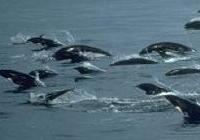 |
|
Genus Lissodelphis
The name "rightwhale dolphin" supposedly comes from the fact that these species and the right whale both lack dorsal fins. Aside from that, the two species are not similar at all. The right whale is a huge, slow-swimming, and ponderous mysticete, while the rightwhale dolphin is possibly the most slender of all cetaceans, often described as "eel like." Melville, the writer of Moby Dick, attributed the common name to the dolphins' frequent appearance with right whales. Both the northern and southern rightwhale dolphins have extremely narrow tail stocks and flukes that are no wider than the widest part of the body. Rightwhale dolphins are often found in groups of around 50 individuals. | |||||
 Distribution Map
Distribution Map(Click for larger version) |
The name Lissodelphis borealis means "smooth dolphin of the north wind." The northern rightwhale dolphin comes from the Northern Pacific, in a crescent-shaped region corresponding to the moderate temperate currents. It has not been seen entering tropical waters, and only rarely are individuals observed in subarctic or the coldest temperate waters. The rightwhale dolphin is not known from the mid-Pacific. The dorsal side is jet black, while the ventral side has a unique white pattern. A sharp demaracation separates the two color regions. The flippers are all black, while the dorsal fin is black on the upper side and white on the lower side, with a trailing border of gray. Fully grown northern rightwhale dolphins are normally around 3 meters in length. The jaws are narrow and pincerlike. It does not appear to be terribly abundant, and due to its rarity and offshore habitat, it was not well known until recently. There are only a few observations of its behavior in the wild, as it is rather difficult to approach. Northern rightwhale dolphins are very quick and active, frequently leaping out of the water. It is possible that both the eastern and western populations migrate north during the summer months, as it is known to prefer cooler waters. It is often seen with other cetaceans, especially Pacific white-sided dolphins, pilot whales, Dall porpoises, and common dolphins. There are records of individuals riding the pressure waves of gray whales, but the nothern rightwhale dolphin does not appear to be an enthusiastic bow rider. When together with the white-sided dolphin, it has been seen riding the bow waves of ships, but it otherwise stays away from ships. Herd sizes seem to range form 1 to 3000, and groups have been observed jumping in unison. | |||||
 Distribution Map
Distribution Map(Click for larger version) |
The southern rightwhale dolphin has a circumpolar distribution in the southern hemisphere, located almost entirely in temperate waters. It is an offshore species with a remote habitat. Not quite as slender as its northern counterpart, it is the only other blue-water dolphin to lack a dorsal fin. There are only a few published photographs, but it does not seem to have the narrow, pointed jaws of the nothern rightwhale dolphin. The head looks heavier and more substantial, but that may only be a result of its white coloration. The color pattern is unique, with a shiny black dorsal side and a snowy white ventral side. The white comes up much higher on the sides than the northern rightwhale dolphin; in the latter the white area is only a ventral streak. The face is white, and the black dorsal coloration meets in a widow's peak just forward of the blowhole. The flippers are white on both sides. There is often a broad black region on the black part of the flippers. The thoracic region is flattened, and the body is wider than it is tall. The flattened body may be a stablalizer for not having a dorsal fin, but the northern rightwhale dolphin does not have this feature. The southern rightwhale dolphin is somewhat smaller than the northern, with a maximum length of 2.1 meters, and most individuals smaller than that. One observer noted that while swimming, the southern rightwhale dolphin looks like a giant penguin. Southern rightwhale dolphins like to associate with dusky dolphins. | |||||
|
BibliographyBaker, Mary L. Whales, Dolphins, and Porpoises of the World. New York: Doubleday & Company, Inc., 1987. Carwardine, Mark. Eyewitness Handbooks: Whales, Dolphins, and Porpoises. New York: Dorling Kindersley Ltd., 1995. Ellis, Richard. Dolphins and Porpoises. New York: Alfred & Knopf, Inc., 1982. Klinowska, Margaret. Dolphins, Porpoises, and Whales of the World: The IUCN Red Data Book. Gland, Switzerland: World Conservation Union, 1991. |
|
© 1998 Thinkquest Team 17963 <17963@advanced.org Modified: 29 August 1998, Created: 9 August 1998 |

 A school of Northern Rightwhale Dolphins
A school of Northern Rightwhale Dolphins